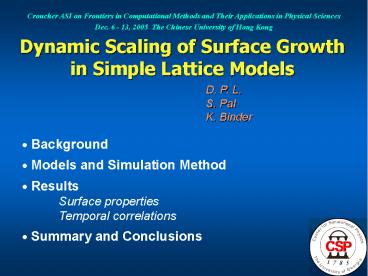Dynamic Scaling of Surface Growth in Simple Lattice Models PowerPoint PPT Presentation
Title: Dynamic Scaling of Surface Growth in Simple Lattice Models
1
Dynamic Scaling of Surface Growth in Simple
Lattice Models
Croucher ASI on Frontiers in Computational
Methods and Their Applications in Physical
Sciences Dec. 6 - 13, 2005 The Chinese
University of Hong Kong
D. P. L. S. Pal K. Binder ?
Background ? Models and Simulation Method ?
Results Surface properties Temporal
correlations ? Summary and Conclusions
2
Simulation
NATURE
Experiment
Theory
3
Simulation (Monte Carlo)
NATURE
Experiment (MBE, LEED, RHEED)
Theory (Growth eqns.)
4
Why MBE?
- the promise of designer materials e.g. mu
ltilayers ________________
quantum wires (vicinal surfaces)
Theoretical questions binding energies - Quant
Mech large scale structures - Stat Mech
5
Theoretical Background
? non-equilibrium (equilibrium ? roughening
transition) define height above L? L
substrate mean height surface
width structure factor
? local order parameter
6
Comprehensive growth equation
random noise ?
h deviation of surface height from the
mean
7
Edwards-Wilkinson growth equation(sedimentation)
random noise ?
h deviation of surface height from the
mean
8
Question What happens when t ? ? ? simple
model studies EW sedimentation model (Edwards
Wilkinson, 1982) KPZ equation (Kardar, Parisi
Zhang, 1986) random deposition (Family,
1986) restricted SOS model (Kim Kosterlitz,
1989) growth-diffusion model (Wolf Villain,
1990) MBE models (Pal and Landau, 1993) and
many more . . .
9
Surface Width Dynamic Finite Size Scaling
Define z ?/? dynamic exponent
10
Computational Study of Film Growth
Surface Science ? Statistical
Mechanics Multiple processes deposition
diffusion Methods ? Ab initio Molecular
Dynamics ? Classical Molecular Dynamics
(phenomenological potentials) O ? O O
OOO OO OO ? surface ? Discrete stochastic SOS
models ? surface
11
Atomistic Edwards-Wilkinson Model
? L? L square lattice substrate (p. b. c.) ?
Growing film held at constant temperature T ?
Particles fall randomly on the surface, then
diffuse to the neighboring site with the
greatest depth
? constant flux
12
Atomistic Edwards-Wilkinson Model
- BUT, what if more than one neighboring site has
the same depth?
? constant flux
13
Atomistic Edwards-Wilkinson Model
- BUT, what if more than one neighboring site has
the same depth? - Generate a random number to decide!
? constant flux
14
(No Transcript)
15
Monte Carlo is Serious Science!
16
Simulations of MBE Monte Carlo (MC) versus
Kinetic Monte Carlo (KMC)
Deposition diffusion ?
O OOOOOOOOOO MC KMC
In KMC we must consider more than just the final
particle state!
17
MBE Model Growth (KMC)
UDP Model
RHEED intensity-growth of GaAs
(Neave et al, 1985)
18
MBE Model Growth (KMC)
What happens at long times?
Dynamic finite size scaling shows z1.65 But the
Edwards- Wilkinson eqn. yields z2.0
19
Atomistic 21 dim EW Model
Interfacial width What happens at long times?
(Note For large systems gt1010 random numbers are
needed per run)
20
Atomistic 21 dim EW Model
Interfacial width Dynamic Finite Size
Scaling for the EW equation ? 0 , so
21
Atomistic 21 dim EW Model
Interfacial width Dynamic Finite Size Scaling
22
Atomistic 21 dim EW Model
Interfacial width Dynamic Finite Size Scaling
23
Atomistic 21 dim EW Model
Structure Factor Dynamic Finite Size Scaling
24
Atomistic 21 dim EW Model
Structure Factor Dynamic Finite Size Scaling
25
Atomistic 21 dim EW Model
Structure Factor Dynamic Finite Size Scaling
- Data do NOT scale for z2.0 !
26
Atomistic 21 dim REW Model
Restricted Edwards-Wilkinson Model When two or
more neighboring sites have equal depth, the
particle does not diffuse!
27
Atomistic 21 dim REW Model
Interfacial width What happens at long times?
28
Atomistic 21 dim REW Model
Interfacial width Dynamic finite size scaling
- Data scale (for long times) with z2.0 !
29
Atomistic 21 dim REW Model
Structure factor Dynamic Finite Size Scaling
30
Atomistic 21 dim REW Model
Structure factor Dynamic Finite Size Scaling
31
Growth equation
h deviation of surface height from the mean
surface stiffness Measure surface properties
numerically
Average quantities over b? b blocks of sites ?
32
Growth equation
h deviation of surface height from the mean
generalized noise Measure
surface properties numerically
Average quantities over b? b blocks of sites ?
33
Atomistic 21 dim EW Model
Surface stiffness
Stiffness decays to a constant value
34
Atomistic 21 dim EW Model
Non-equilibrium contribution to the interface
velocity
i.e. generalized noise
35
Atomistic 21 dim EW Model
Non-equilibrium contribution to the interface
velocity
36
Atomistic 21 dim EW and REW Models
Non-equilibrium contribution to the interface
velocity
For random noise, U(b,t) should decay to 0 !
37
Time-displaced Correlation Function
To study temporal correlations in U(b,t), define
blocking factor
38
Time-displaced Correlation Function
EW model (finite size effects)
Note C(b,?) is independent of L
39
Time-displaced Correlation Function
EW model (time dependence)
C(b,?) decays non-exponentially !
40
Time-displaced Correlation Function
REW model
Correlations decay exponentially fast to 0 !
41
Time-displaced Correlation Function
Dynamic scaling
where
42
Time-displaced Correlation Function
EW model
z
43
Time-displaced Correlation Function
EW model (define P(b,?)C(b,?)/? ? (b)-1 )
For b gt 15, get scaling with z 1.65
44
Time-displaced Correlation Function
EW model
No scaling for z 2.0 !
45
Summary and Conclusions
- Simple lattice models for surface growth have
behavior that depends on the noise - The atomistic EW model does not have the same
- behavior as the EW equation!
- but the REW model ? the EW equation.
- Time-displaced correlations are non-exponential
for the atomistic EW model ? the use of a random
number to choose one of the degenerate neighbor
sites creates a 2nd source of (correlated) noise. - Challenge for the future
- - Study other models by simulation to extract
the noise ? Universality classes?

